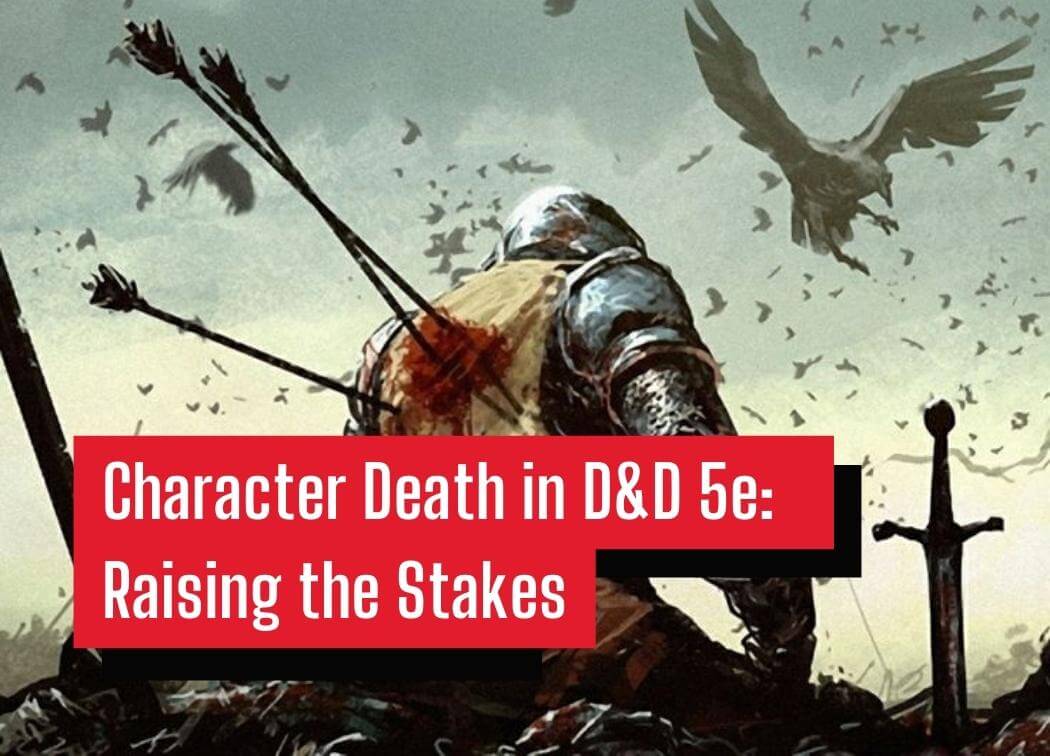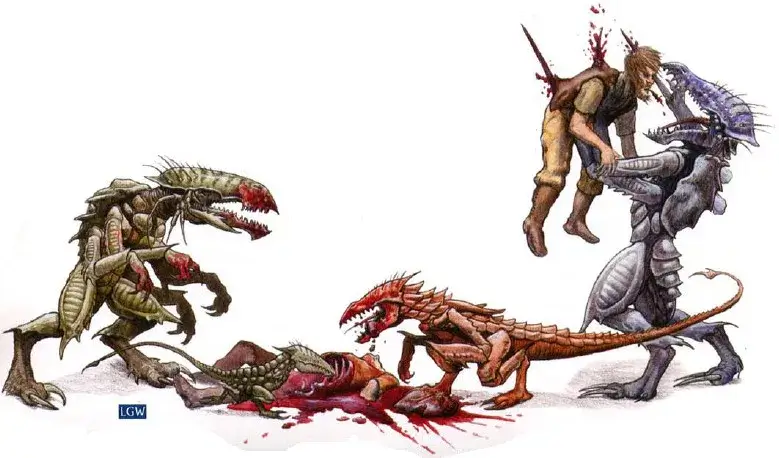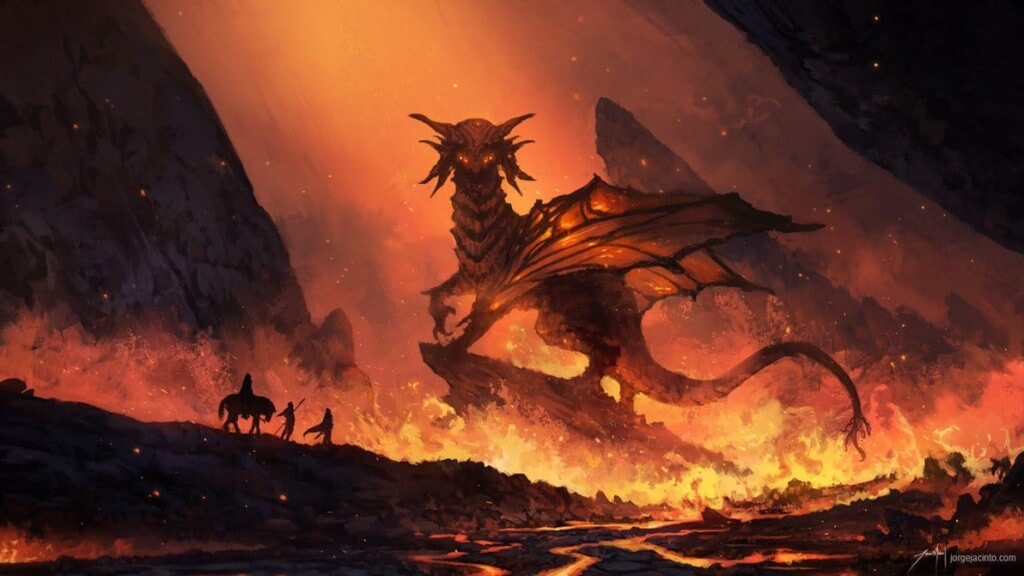Character Death in D&D 5e: Raising the Stakes

The first time a character death happens while you’re DMing is a big deal. You’re not sure how the player will react. Even if you discussed as a group how comfortable they are with losing a character, you’ll still have that initial panic.
The first time a character death happens for you as a player it’s also a huge deal. You’ve created an extension of yourself whose story has just ended. What happens now is out of your hands. Will you be resurrected or do you have to create something new?
Death is a bitter part of RPGs and D&D 5e in particular. I’ve killed players and I’ve died as a player and it’s almost always a defining moment of the campaign when it happens. Every player is affected by the death and the story is as well. It adds a new element to the game – permanent loss.
Character Death Keeps the Stakes High
I’m of the mind that as a DM you should never strive to kill a PC. However, if the inevitable happens you shouldn’t shy away from it either. It is a crucial component for keeping the story intact because death is a major consequence. It may have been a risk that didn’t favor the character, or it could’ve just been very awful luck.
Regardless of what ended up being the character’s ultimate demise, they have now made an important impact on the game. Does the party find a way to resurrect their fallen companion? Does the player instead opt to play a new character that may alter the group’s dynamic? How is the party affected by the death of their friend?
Any of those questions can lead to some significant plot hooks and storytelling elements. This is important for D&D as a game because it’s ultimately a story that everyone takes part in telling.
Consequences for Your Actions
Another element of character death, especially the first death of a campaign, is that the players learn that they are not always able to defeat their foe or avoid a dangerous situation. Death is the ultimate price and can happen for any reason.
In a game without death or where the DM is unwilling to kill a PC, the players know that their characters will always succeed or get escape their deaths. In most cases, they’ll continue to up their antics and take bigger risks.
For some games this is fine, but for many, it will eventually derail any tensions you want to build up. There has to be a reason that the characters play it safe or think their strategies through. Avoiding death is generally the biggest reason for both of these things.
Risks that could result in death also feel a lot more meaningful. If there’s truly a fear that the character may die it makes their willingness to throw caution to the wind and take a leap of faith that much more impactful when it works out for them.

Death Mechanics in D&D 5e
It’s pretty difficult for a character death to happen in D&D 5e especially if you have a healer in the group or potions of healing. 5th edition is by far one of the most forgiving RPGs I’ve played in terms of its death mechanics.
As a player, you typically have multiple chances to stabilize yourself that span a few rounds which gives your allies plenty of time to heal you or stabilize you themselves.
I like this about D&D 5e because when a character death does happen it ends up being pretty significant to the game and often very memorable.
You can find the death mechanics rules on pages 197 – 198 of the Player’s Handbook, but I’ll dive into them now.
Death Saving Throws
Once a character starts their turn with 0 hit points they have to make a death saving throw. Like other saving throws this is done using 1d20, however, unlike other saving throws it’s not tied to an ability so you have no bonus when making this saving throw. However, there are some class features, spells, and magical items that can affect your saving throw.
If the outcome is a 10 or higher you mark a success down on your character sheet. If the outcome is 9 or lower it’s a failure. On your 3rd success, you become stable, and on your 3rd failure, you die.
If you roll a 1 you mark down 2 failures instead which can bring you immediately to death’s door or immediately kill you. However, if you roll a 20 you automatically regain 1 hit point and no longer have to make death saving throws.
If you take any damage while you are at 0 hit points you suffer a failure. If you suffer a critical hit you mark down 2 failures. Since you are prone any melee attack against you is going to be considered a critical hit.
Stabilizing a Dying Creature
While death saving throws are not necessarily unique to PCs they pretty much always are in terms of actual play. That being said, if a creature or party member is suffering death saving throws you can attempt to stabilize them at any point in time. This can be done in a few different ways.
The most obvious is by healing the dying character using a spell, feature, or magical item. If a character is healed back to at least 1 hp they can immediately rejoin the fray on their next turn.
Another easy way is by using a healer’s kit to automatically stabilize the dying character or by making a DC 10 Medicine check without a kit. If a character is stabilized without regaining any hit points like with these methods or by making 3 successful death saving throws, the character then has to roll 1d4 for how many hours it takes them to regain 1 hit point.

Instant Death
A massive amount of damage can flat-out kill a character permanently. When damage drops a character down to 0 hit points and there is remaining damage you then must determine if the remaining damage would be greater than or equal to the character’s maximum hit points. If it is the character is immediately killed and cannot make death saving throws, be healed, or be stabilized.
For example, Timmy has 15 hit points at full hp. Timmy rolls a 3 on a Dexterity Saving Throw to avoid a Fireball. The fireball deals 30 damage and Timmy does not have any resistance to the damage. He is dropped to 0 there is still 15 damage remaining. Timmy’s hit point maximum is 15, therefore he is immediately killed by the flames.
For reference, I’ve only had an instant death happen twice in my hundreds of hours playing and DMing D&D 5e. They happened in literally the same combat encounter with level 2 PCs. It’s really difficult for this to happen.
Death Isn’t Always Permanent
At this point, we’ve established that player character death is a powerful way to keep the stakes high and ensure that risks a meaningful in D&D. In 5e specifically it’s usually pretty difficult to die given the fact that you normally will have at least 3 full rounds of death saving throws before Despite this it still sucks to have a player’s favorite character die so it’s only natural that the player or the whole party will want to revive their friend and bring them back.
Resurrection Spells
The good news is that there are plenty of options for bringing a character back from death. You’ve got resurrection, revivify, and reincarnate just to name 3, but there are plenty of other spells. Revivify costs only 300 gp worth of diamonds and can be learned by a cleric or paladin as a 3rd level spell.
For reference, this means that a divine soul sorcerer or a cleric can bring a dead creature back to life at level 5, provided that the creature has only been dead for 1 minute.
After this point characters tend to become very difficult to permanently kill off as they continue to gain more powerful healing and damage avoiding abilities. This doesn’t even begin to include the various magical items your character may have that could help prevent death or provide another method of resurrection.
Friends in High Places
Unfortunately, your party will not always have the ability to resurrect their fallen friends themselves. This is especially true in the earlier portion of the game where it is much easier to be killed.
However, in many cases, DMs will present other options for resurrecting your characters. One of the most common ways of doing so is by paying or doing a favor for a powerful priest or cleric of a church.
There are plenty of avenues a DM can provide to the party in terms of resurrecting fallen characters. That being said, as a DM you should make your party earn the resurrection. Especially at the lower levels where they most likely won’t have the money to resurrect someone.
However, there are times where it will not make narrative sense to revive the character. For example, if there’s no body most of these spells won’t work no matter how powerful the priest or cleric is. You may also not have access to a place with an NPC powerful enough to cast 7th level spells. Lastly, the character may just want to stay dead!
Keeping the Stakes High Without Death
Maybe your group as a whole isn’t a fan of character death. You all have spent a lot of time creating awesome characters and you want to see how their story plays out. There’s nothing wrong with this.
However, you now need something to take the place of death in your game. There has to be some sort of consequence for dropping to 0 hp and failing your death saving throws. This consequence has to be undesirable enough that the stakes are still high in combat and taking unnecessary risks that would normally result in death is still intense.
There are plenty of mechanics and other ideas that you can come up with to substitute character death. Here are a few common ones that I’ve read about or used in the past.
Losing Character Progression
After dying you’re resurrected somehow, but you still lose something. Maybe you lose some of your points in an ability score, some experience points, or even a whole level. Whatever it is, death took a lot out of you and it required a form of payment. You can earn it back, but you have been forever weakened compared to your peers.
I’m honestly not a fan of this at all. I dislike singling out a single character and making them inherently weaker than their peers. I’ve mentioned before that it’s not fair or fun for the player and typically makes the DM’s job more difficult in the long run. It also only makes this character more likely to die as they’ve been weakened to a significant degree.
Regardless, if your table is all for it then I say go for it. It can certainly make for a very high-stakes game and if that’s what everyone enjoys then all the power to you!
Making a Deal with a God
I like this outcome as it affects both the character and the story. The character didn’t want to die, it just happened and now they’re traveling to whatever afterlife lies ahead for them. A god notices this and strikes a deal with the character. They want something from them and will grant them the ability to return to their body in the mortal realm.
The character makes a promise to the god. Maybe they have to retrieve a powerful artifact or foil the plans of the god’s adversary. Whatever it is, the character now has a quest they have to fulfill which presents a brand-new plot point for the campaign.

The Character is Forever Altered
This outcome is similar in spirit to the Losing Character Progression method I’ve already talked about. However, it’s not always necessarily bad and the outcome does not have to be permanent.
One example of this is losing body parts, senses, or other physical attributes. This can all be regained through magic or some other means in D&D, or the character can decide to live with this alteration. The character has a choice in what they do now and how they live their life.
Another example is that whatever lies in the afterlife has forever changed the character. Whatever they saw and interacted with has altered their personality or has given them a new perspective. This can also be tied in with the Making a Deal with a God method!
Conclusion
In conclusion, I believe death is a powerful storytelling tool and it helps to keep the stakes high for your adventuring party. Risks should feel like actual risks. If the party knows they are going to get out of everything bloodied, bruised, but ultimately successful they’ll become reckless and their choices will ultimately not matter that much.
On the other hand, dying sucks. Especially when it’s permanent. While it’s difficult to permanently die the more powerful your PCs get, it sucks when it does happen to you. You grow attached to your character and you want to tell their story. Not being able to can be frustrating. So I understand why many people do not kill off PCs. In that case, you still need to find a way to keep the stakes high.
Character death is not necessary, but it’s a powerful part of RPGs and storytelling overall.

Hi there,
This weekend I started playing my very first DnD campaign (Blue Alley), with two other newbies, and a moderately experienced player. Unfortunately, only ~3 hours after starting out, my first character suffered an instant death by trap. Naturally this was incredibly upsetting, and in looking up thoughts about character death online, I was even more disheartened to see that apparently instant death is rare, if you’ve only seen it twice in hundreds of hours. So I guess I was just ridiculously unlucky. I keep hearing various friends talk about having fun with DnD, but I’m not sure how fun this game can be if I’m just going to die in every campaign. I plan to ask the DM to retcon the death when we start our next session (we ended after the trap went off) but any advice for processing all this and how to do better next time I play?
Thank you in advance.